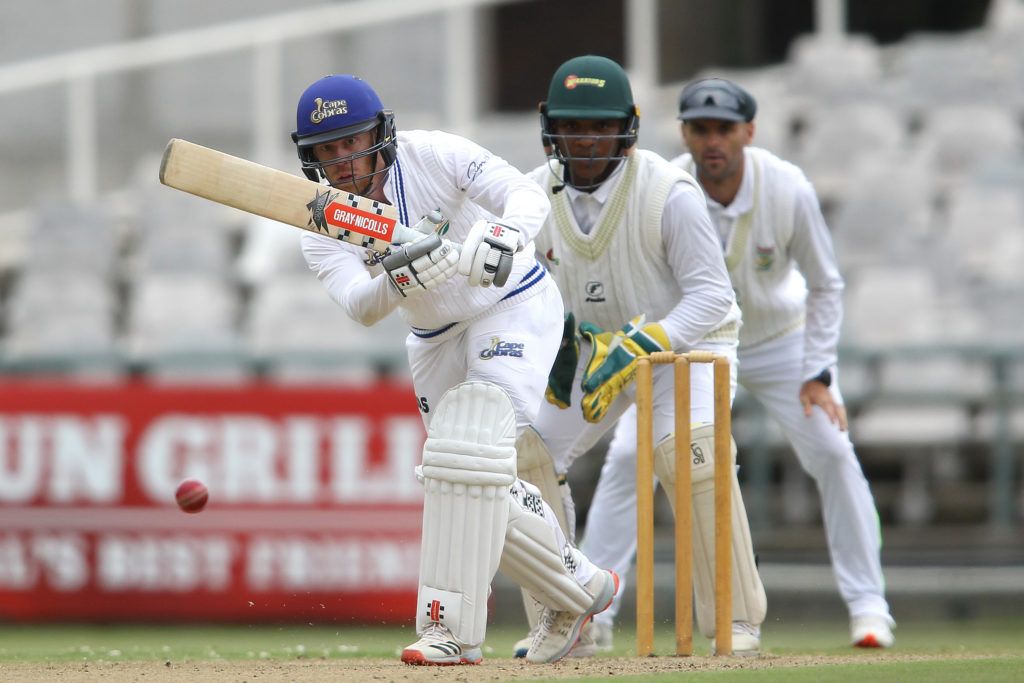Kyle Verreynne can no longer be denied a Proteas Test spot, and there needs to be a broader, bold selection philosophy that rewards domestic form in order to arrest the team’s batting mediocrity.
Verreynne continued his red-ball excellence on Monday, scoring 216* at Newlands. The 23-year-old Cobras player is in excellent form, scoring 39,85,51,72,97 and 214* in his last six innings in the 4-Day Domestic Series.
He has built on an excellent 2019-20 red-ball campaign, during which he scored 551 runs at an average of 55.10 (two 100s, three 50s) with an impressive strike rate of 76.74. He averaged 40 in the 2018-19 season, indicating a clear pattern of year-on-year improvement. His time is now.
The debate around Verreynne has been whether a Test side can accommodate both him and Quinton De Kock. This view has been embarrassed by Verreynne’s relentless run gluttony.
It also takes off the table the option of Verreynne playing instead of De Kock, which seems to be unconscionable to most, despite De Kock averaging 25 in his last 10 innings, and just 11.20 in his last five.
De Kock is a generational talent, and I don’t think he should be dropped. However, I also don’t believe his historical contributions should shield him from criticism. This type of grace isn’t extended to his teammates and shouldn’t be offered to De Kock.
Being critical of his present-day struggle, doesn’t mean I think this struggle will define him. I hope De Kock’s immense talent soars once again in all formats. He is a national treasure, and his performances in the Test arena will take on added significance in light of Faf du Plessis’ retirement.
So, I believe there is space for De Kock and Verreynne to co-exist in the national Test team. I’ve expressed the view in the past that De Kock should be freed of the wicketkeeping responsibility and given the mandate to play freely at No 4.
The likelihood of him occupying that now vacant No 4 slot is slim because the selectors’ appetite for experimentation is diminished, given their dire Test form (they’ve won just six of their last 18 Tests, two of those against a Sri Lanka side crippled by injuries). It is more likely that De Kock will continue to bat at No 6, which would require some reshuffling to accommodate Verreynne.
It is unlikely that the Proteas will play two spinners outside the subcontinent, which means the spot George Linde occupied for the tour of Pakistan is up for grabs. I’d bat Verreynne at No 7, followed by Wiaan Mulder at No 8, anywhere outside the subcontinent.
Keegan Petersen has been knocking on the door of national selection for three years and this should put him in front of the queue to replace Du Plessis at No 4. He has averaged 50 or above for three straight seasons in domestic four-day cricket, and has currently amassed 394 runs across nine innings (two not-outs), which has included a century and fifty, at an average touching 57.
Raynard van Tonder’s domestic form should be giving Rassie van der Dussen sleepless nights. The 22-year-old leads the run-scorers rankings in the CSA 4-Day Cup, having scored 656 runs at an average of 65.60. This run tally includes two hundreds and two half-centuries across his 11 innings.
Van der Dussen is 14 innings into his Test career and averages 34.64. This is a respectable record, and one that I imagine the selectors think warrants further investment. However, Van der Dussen will know that he has to convert the numerous starts (he has gotten out between 50 and 100 in six of his 14 innings) in order to establish himself.
Personally, I’d be bolder and pick Van Tonder while he’s hot. It leaves the batting a little short of experience in the key three and four slot, but the potential return on any investment in Van Tonder is high in the medium to long term, whereas, at nearly 32 years old, Van der Dussen is nearing the home stretch of his career.
This combination of players leaves the Proteas vulnerable on the bowling front. I think they can carry four bowlers in South Africa, with Aiden Markram contributing on the spin front to supplement the attack. The batter-bowler split will require some bravery, and a fair measure of faith that none of the four break down, but it would go a long way to addressing chronic struggles to get beyond 300, particularly in the first innings, which they’ve achieved just twice under Mark Boucher.
The alternative would be to invest in Migael Pretorius, who is the leading wicket-taker in domestic four-day cricket. He also averages nearly 29, with two half-centuries. This would require one of Petersen or Van Tonder miss out. It is likely to be the latter in this scenario, given how long Petersen has waited for his shot.
Whatever option the Proteas selectors go with, the guiding philosophy has to be that they reward consistency of performance in domestic cricket, and that there are consequences for habitual underperformance of the Test incumbents.
Option 1: Loaded batting
1. Dean Elgar
2. Aiden Markram
3. Raynard van Tonder
4. Keegan Petersen
5. Temba Bavuma
6. Quinton de Kock
7. Kyle Verreynne
8. Wiaan Mulder
9. Keshav Maharaj
10. Kagiso Rabada
11. Anrich Nortje
Option 2: A more traditional approach
1. Dean Elgar
2. Aiden Markram
3. Keegan Petersen
4. Temba Bavuma
5. Kyle Verreynne
6. Quinton de Kock
7. Wiaan Mulder
8. Migael Pretorius
9. Keshav Maharaj
10. Kagiso Rabada
11. Anrich Nortje







